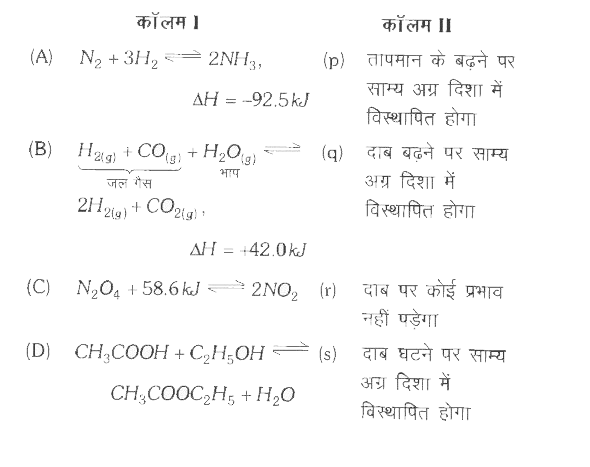प्रकथन: अभिक्रिया के लिए की इकाई
कारण: अभिक्रिया
के लिए साम्य स्तिथ्रांक
प्रक्कथन और कारण दोनों सही हैं और कारण प्रक्कथन का सही स्पष्टीकरण देता है
प्रक्कथन और कारण दोनों सही हैं किन्तु कारण प्रक्कथन का सही स्पष्टीकरण नहीं देता है
प्रक्कथन सही है किन्तु कारण गलत है
प्रक्कथन और कारण दोनों गलत हैं
The correct Answer is:A
Topper's Solved these Questions
- BOOK - ERRORLESS HINDICHAPTER - रासायनिक साम्य EXERCISE - JEE ADVANCED (MATRIX MATCH TYPE QUESTIONS)1videos
रासायनिक साम्य
- BOOK - ERRORLESS HINDICHAPTER - रासायनिक विश्लेषणEXERCISE - Assertion & Reason16videos
रासायनिक विश्लेषण
- BOOK - ERRORLESS HINDICHAPTER - रेडॉक्स अभिक्रियाएँ EXERCISE - Assertion & Reason9videos
रेडॉक्स अभिक्रियाएँ
Similar Questions
इस खण्ड में कुछ प्रश्न है। प्रत्येक प्रश्न में कॉलम-1 में कुछ कथन (A, B, C और D) और कॉलम-II में कुछ कथन (p, q, r, s और t) है। कॉलम-1 का कोई भी कथन कॉलम-II के एक कथन या एक से अधिक कथनों से मेल खाता है। उदाहरण के लिए, दिए हुए प्रश्न में यदि कथन B कथनों और r से मेल खाता है, तो ORS में उस प्रश्न के लिये कथन B के सामने और से संबंधित बुलबुलों को काला कीजिए।
कॉलम । में दी गई प्रविष्टियों को कॉलम II में दी गई प्रविष्टियों से सुमेलित कीजिए।
 01:33View Solution
01:33View Solutionनिम्नलिखित प्रश्नों में प्रक्कथन (Assertion) के वक्तव्य के पश्चात् कारण (Reason) का वक्तव्य है।
प्रक्कथन : चूने का पानी CO2 प्रवाहित करने पर धुंधला हो जाता है किन्तु अधिक CO2 प्रवाहित करने पर साफ हो जाता है।
कारण : चूने का पानी कैल्शियम हाइड्रॉक्साइड, Ca(OH)2 होता है।01:24View Solutionप्रक्कथन : SO2 एवं Cl2 दोनों ही विरंजक हैं।
कारण : दोनों अपचायक हैं।02:38View SolutionFor the reaction, N_(2)(g)+3H_(2)(g) hArr 2NH_(3)(g) , the units of K_(p) are …………
01:17View SolutionFor N_(2)(g) + 3H_(2)(g) rarr 2NH_(3)(g) + 22kcal , E_(a) for the reaction is 70 kcal . Hence, the activation energy for 2NH_(3)(g) rarr N_(2)(g) + 3H_(2) (g) is :
View SolutionFor the reaction
2NH3(g)⇔N2(g)+3H2(g) the units of Kp will be01:50View SolutionAssertion (A) : For the reaction N_(2)(g) +3H_(2)(g) hArr 2NH_(3)(g) unit of K_(c) =L^(2) mol^(-2) Reason (R ) : For the reaction N_(2)(g)+3H_(2)(g) hArr 2NH_(3)(g) equilibrium constant K_(c)=([NH_(3)]^(2))/([N_(2)]xx[H_(2)]^(3))
01:26View SolutionFor the reaction : N_(2)(g)+3H_(2)(g)=2NH_(3)(g) Equilibrium constant K_(c)=([NH_(3)]^(2))/([N_(2)][H_(2)]^(3))
03:01View SolutionWrite the relation between K_(p) " and " K_(c) for the reaction: N_(2)(g) +3H_(2) (g) hArr 2NH_(3)(g)
02:58View SolutionFor the reaction, N_(2)(g)+3H_(2)(g) to 2NH_(3)(g)
02:39View Solutionअभिक्रिया N2(g)+3H2(g)⇔2NH3(g) के लिए Kp=Kc(RT) ............
04:16View SolutionDerive the relation between Kp and Kc for the equilibrium reaction.
N2(g)+3H2(g)⇔2NH3(g)05:48View SolutionFor the reaction, 2NH3(g)→N2(g)+3H2(g)-
View SolutionK_(p) and K_(p)^(**) are the equilibrium constants of the two reactions, given below (1)/(2)N_(2)(g)+(3)/(2)H_(2)(g)hArr NH_(3)(g) N_(2)(g)+3H_(2)(g)hArr 2NH_(3)(g) Therefore, K_(p) and K_(p)^(**) are related by
01:31View SolutionEquilibrium constant KC for the following reaction at 800 K is, 4 NH3(g)⇔12N2(g)+32H2(g).
The value of Kp for the following reaction will be
N2(g)+3H2(g)⇔2NH3(g)02:25View Solution

